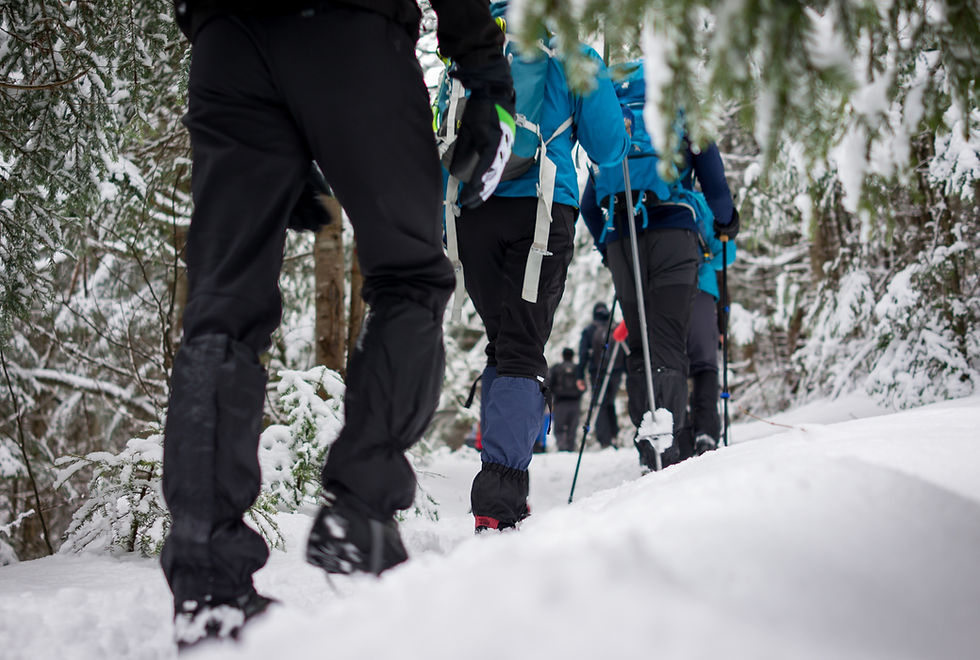How to hike on Snow
- Josh Welch

- Jul 30, 2022
- 3 min read
In a hot country like Australia you might not immediately think of snow when I say hiking but around the country there are tons of snow hikes which are enjoyed by hikers every year. Knowing the key principles of how to walk on these surfaces can be very important in maintaining the safety of yourself and others out on the trail and that's why we will cover both how to hike on partial and full snow.

What to know about hiking in the snow
No matter if it is partial or full ice and snow its important to start your preparations with a good pair of shoes. These shoes should have good traction and be waterproof, these boots should allow you to walk on snow and ice with less chance of slipping and are best if they are custom designed specifically for snow and icy conditions (ie. snowshoes).
Hiking poles are another great tool to have with you when hiking in the snow as they can help you get a little more balance while walking and help avoid those occasional slips. When hiking in the snow, make sure you have your pointy tips on your poles by removing the rubber caps that cover them at their base. This will allow for the poles to stick into the ground with much better force and will mean you can push on them without the risk of them sliding.
Hiking on partial ice and snow
At the core of walking on icy and snowy tracks is having good balance. As we said above good shoes are a key part of this alongside a good set of hiking poles. Having a nice wide stance that is sturdy is important when taking steps in snow and icy conditions in order to avoid any slipping and sliding.
Travelling early in the morning is another way to keep safe as the low heat of an early morning will mean any snow or ice on the trail will be much firmer and easier to walk on.
While hiking in areas of partial ice and snow you will find yourself passing through patches of ice or snow followed by patches of dirt and other surfaces like hardened mud. Making a smooth transition between these areas is important to avoid slipping so letting the people hiking with you know that there are patches coming up is a must. When you can, try stick to the areas of dry non-icy track because you will almost certainly get more traction on these surfaces.
Hiking on full ice and snow
Much like hiking in partial ice and snow the key is to try maintain balance. Avoiding leaning too far forward, good quality hiking poles and a decent pair of shoes made for snow are all brilliant ways of achieving this but if the conditions are extra icy you may need some extra help to walk safely in these areas.
Crampons and traction spikes are both fantastic tools if you are walking in places with lots of snow and ice. They will help place each step firmly on the ground and avoid slides which can easily and quickly become a fall.
Though they may be a great tool they are not good in all conditions including areas of soft, slushy snow. When you walk on this soft snow you will get a build-up of ice and snow on the base of your boot which over time will mean you will get less and less traction from the points of the crampon or traction spikes on the ground. For this reason it is best to use these tools only for walking on this harder and firmer ground rather than the soft snow.
For this slushy snow you will definitely want some specially made snowshoes which will give the most grip in these conditions. They can sometimes be expensive but if you are a hiker who walks frequently in these conditions then the investment is certainly worth it.

Hiking in the snow can be a unique experience that is very different to any other surface and this is certainly reflected in the challenges of keeping safe while walking on it. If done right it can be a ton of fun so don't be afraid of giving it a go but do take some safety precautions to make sure you get home with no injuries.
Written by Josh Welch





ความคิดเห็น